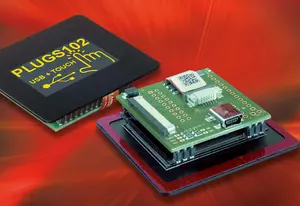High-contrast OLED with USB interface
Especially for small monitoring and control tasks, the display specialist ELECTRONIC ASSEMBLY has developed a graphic OLED display with touch-sensitive front made of real glass.
The brand new EA PLUGS102-6 is not only a display, but also a full control unit featuring a wide range of interfaces. Its 36 x 25 mm display area offers a resolution of 102 x 64 pixels. Since every pixel in OLEDs represents a light source, this panel boasts unbeatably brilliant color, low black levels and strong contrasts compared to any LCD displays.
All these features are provided from any viewing angle at almost 180°, because OLEDs do not exhibit the LCD-typical weak contrast at oblique viewing angles. A separate backlight is not necessary. The display brightness can be adjusted by software. Automatic screen saver modes prevent the possible burn-in of static image content.
Thanks to the integrated USB interface, the OLED module can be quickly and easily put into operation. Just plug it in and the display will be automatically powered. The data transfer takes place serially, either via USB, SPI, RS232 or I2C connection.
For measurement and control tasks, the EA PLUGS102-6 is equipped with eight freely configurable digital I/O interfaces, two analog inputs and one PWM and one analog output. A small loudspeaker is also integrated.
The EA PLUGS102-6 recognizes high-level language-like graphics commands, which can be mastered even without any previous knowledge. In addition to eight integrated fonts, the display also features a number of sophisticated graphic functions. The time-consuming development of character sets and graphic routines is not necessary. Text and graphic elements can be mixed with each other at will, they can be positioned pixel-precisely and provided with blink attributes (on/off, inverse). Up to 256 images and the same number of macros can be stored in the internal memory.
The complete OLED module measures 55 x 54 x 15 mm. Its supply voltage, if not supplied via USB, may range from 3.3 to 5 V. If all pixels are enabled, it typically requires 137 mA or 97 mA. Its operating temperature ranges from -20 to 70 °C. For quick mounting, it is simply glued upright or crosswise into the front panel.
More information at our Website or in the data sheet.

